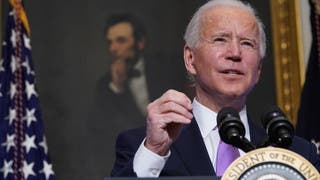
US boosts delivery of COVID-19 vaccines amid shortages
Answering growing frustration over vaccine shortages, President Joe Biden announced that the US is ramping up deliveries to hard-pressed states over the next three weeks and expects to provide enough doses to vaccinate 300 million Americans by the end of the summer or early fall.
Biden, calling the push a “wartime effort,” said Tuesday the administration was working to buy an additional 100 million doses of each of the two approved coronavirus vaccines. He acknowledged that states in recent weeks have been left guessing how much vaccine they will have from one week to the next.
Shortages have been so severe that some vaccination sites around the US had to cancel tens of thousands of appointments with people seeking their first shot.
“This is unacceptable,” Biden said. “Lives are at stake.”
He promised a roughly 16 percent boost in deliveries to states over the next three weeks.
The administration said it plans to buy another 100 million doses each from drugmakers Pfizer and Moderna to ensure it has enough vaccine for the long term. Even more vaccine could be available if federal scientists approve a single-dose shot from Johnson & Johnson, which is expected to seek emergency authorization in the coming weeks.
The Centers for Disease Control and Prevention reported that the government plans to make about 10.1 million first and second doses available next week, up from this week’s allotment of 8.6 million. The figures represent doses of both the Pfizer and Moderna vaccines. It was not immediately clear how long the surge of doses could be sustained.
Governors and top health officials have been increasingly raising the alarm about inadequate supplies and the need for earlier and more reliable estimates of how much vaccine is on the way so that they can plan.
Biden’s team held its first virus-related call with the nation’s governors on Tuesday and pledged to provide states with firm vaccine allocations three weeks ahead of delivery.
Biden’s announcement came a day after he grew more bullish about exceeding his vaccine pledge to deliver 100 million injections in his first 100 days in office, suggesting that a rate of 1.5 million doses per day could soon be achieved.
The administration has also promised more openness and said it will hold news briefings three times a week, beginning Wednesday, about the outbreak that has killed more than 425,000 people in the United States.
“We appreciate the administration stating that it will provide states with slightly higher allocations for the next few weeks, but we are going to need much more supply,” said Maryland Gov. Larry Hogan, a Republican.
The setup inherited from the Trump administration has been marked by miscommunication and unexplained bottlenecks, with shortages reported in some places even as vaccine doses remain on the shelf.
Officials in West Virginia, which has had one of the best rates of administering vaccine, said they have fewer than 11,000 first doses on hand even after this week’s shipment.
“I’m screaming my head off” for more, Republican Gov. Jim Justice said.
Syringes filled with a dose of the Covid-19 vaccine await to be administered at the Kedren Community Health Center on January 25, 2021 in Los Angeles, California. (AFP)
Syringes filled with a dose of the Covid-19 vaccine await to be administered at the Kedren Community Health Center on January 25, 2021 in Los Angeles, California. (AFP)
California, which has faced criticism over a slow vaccine rollout, announced Tuesday that it is centralizing its hodgepodge of county systems and streamlining appointment sign-up, notification and eligibility. Residents have been baffled by the varying rules in different counties.
And in Colorado, Democratic Gov. Jared Polis said that the limited supply of vaccine from the federal government is prompting the state to repurpose second doses as first doses, though he expects that people scheduled for their second shot will still be able to keep their appointments.
The weekly allocation cycle for first doses begins on Monday nights, when federal officials review data on vaccine availability from manufacturers to determine how much each state can have. Allocations are based on each jurisdiction’s population of people 18 and older.
States are notified on Tuesdays of their allocations through a computer network called Tiberius and other channels, after which they can specify where they want doses shipped. Deliveries start the following Monday.
A similar but separate process for ordering second doses, which must be given three to four weeks after the first, begins each week on Sunday night.
As of Tuesday afternoon, the CDC reported that just over half of the 44 million doses distributed to states have been put in people’s arms. That is well short of the hundreds of millions of doses that experts say will need to be administered to achieve herd immunity and conquer the outbreak.
The US ranks fifth in the world in the number of doses administered relative to the country’s population, behind No. 1 Israel, United Arab Emirates, Britain and Bahrain, according to the University of Oxford.
Last Update: Wednesday, 27 January 2021 KSA 15:03 – GMT 12:03




